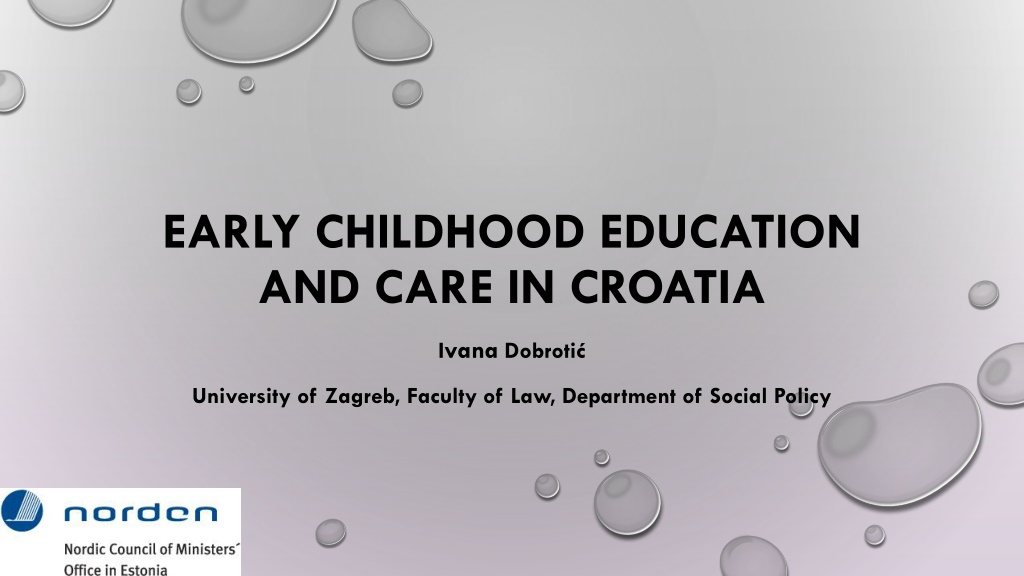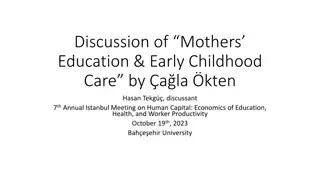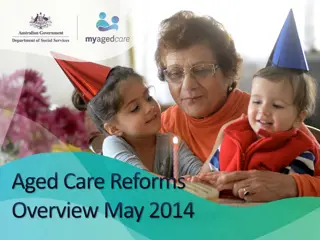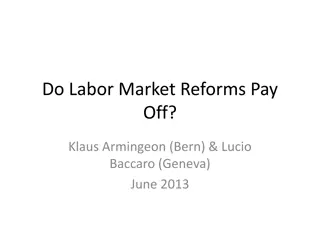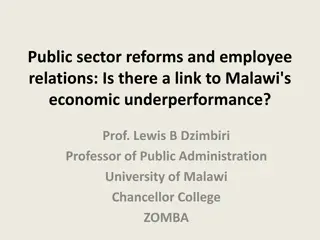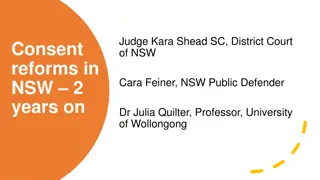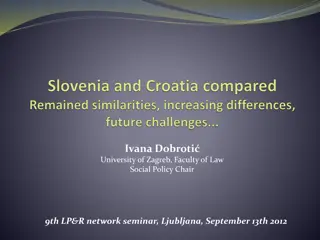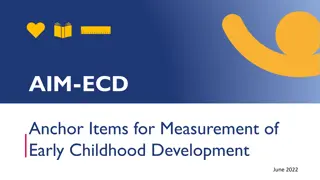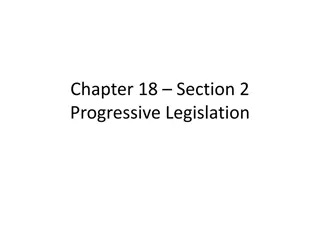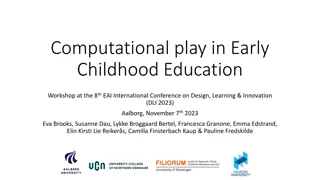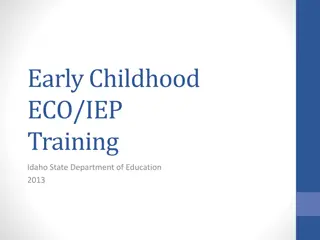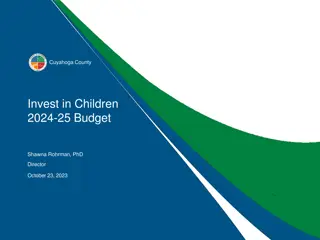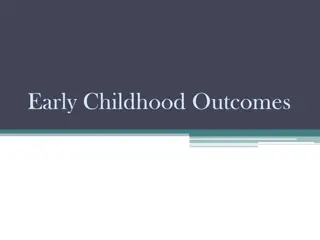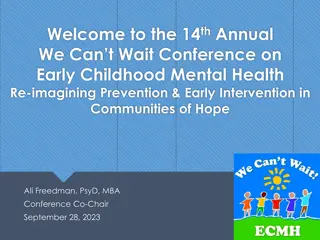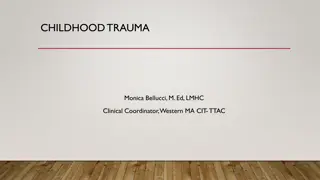Early Childhood Education and Care in Croatia: Overview and Reforms
Early Childhood Education and Care (ECEC) in Croatia has evolved over the years with reforms targeting parental leave, family benefits, and preschool programs. The system includes nurseries, kindergartens, and preschools, with public providers dominating. Recent reforms have introduced quality standards, alternative childcare options, and mandatory preschool programs. Regional disparities persist in ECEC availability and affordability, despite efforts to improve access. The percentage of children in ECEC has shown variations over the years, illustrating the changing landscape of early education in Croatia.
Download Presentation

Please find below an Image/Link to download the presentation.
The content on the website is provided AS IS for your information and personal use only. It may not be sold, licensed, or shared on other websites without obtaining consent from the author. Download presentation by click this link. If you encounter any issues during the download, it is possible that the publisher has removed the file from their server.
E N D
Presentation Transcript
EARLY CHILDHOOD EDUCATION AND CARE IN CROATIA Ivana Dobroti University of Zagreb, Faculty of Law, Department of Social Policy
GDP growth rate 8 6 4 2 0 -2 -4 -6 -8 2002 2003 2004 2005 2006 2007 2008 2009 2010 2011 2012 2013 EU28 Croatia Source: Eurostat (2014)
employment rate, EU28 & HR 90 80 70 60 50 40 30 20 10 0 2005 2006 2007 2008 2009 2010 2011 2012 2013 EU28 20-64 HR 20-64 HR 20-49 EU28 20-49 Source: Eurostat (2014)
Background socialist period until the 1980s - one year maternity leave (100%; mothers & fathers entitled) ECEC - part of educational system; decentralized; lack of capacities & regional differences in ECEC availability, large educational groups etc. reforms since the 1990 aimed at leave system and family benefits (e.g. three years leave, eligibility criteria, benefits level) ECEC - low priority
ECEC main characteristics 6 months until the mandatory school age (nurseries/kindergartens/preschool) usually used on full-time basis entitlement to preschool program from six years of age (250 hours as preparation for school) predominantly public providers admission once per year subsidies and eligibility criteria defined at local level persistent regional differences in availability and affordability
ECEC - main reforms pluralism of providers (1990s) quality standards (1990s/2000s) postponed July 2013 alternative forms of childcare (Act on Nannies) local communities are legally obliged to provide preschool program (one year before the school in duration of 250 hours effective since September 2014)
% of children in ECEC 1990-2012 60% 50% 40% 30% 20% 10% 0% 2002./3. 1989./0. 1990./1. 1991./2. 1992./3. 1994./5. 1995./6. 1996./7. 1997./8. 1998./9. 1999./0. 2000./1. 2001./2. 2003./4. 2004./5. 2005./6. 2006./7. 2007./8. 2008./9. 2009./10. 2010./11. 2011./12. 1993./4. 0-2 3-6 (preschool excluded) Source: Baran, Dobroti and Matkovi (2013)
% of children in ECEC 2012, by counties 100% 90% 80% 70% 60% 50% 40% 30% 20% 10% 0% Brodsko-posavska Osje ko-baranjska Li ko-senjska Karlova ka Zadarska Zagreba ka Istarska Sisa ko-moslava ka Me imurska Vara dinska Po e ko-slavonska Bjelovarsko-bilogorska Splitsko-dalmatinska Krapinsko-zagorska ibensko-kninska Grad Zagreb Dubrova ko-neretvanska RH Primorsko-goranska Viroviti ko-podravska Vukovarsko-srijemska Koprivni ko-kri eva ka 0-2 3-6 Source: Matkovi and Dobroti (2013)
Leaves Obliged maternity leave (100%) Parental leave (100% with low ceiling) Maternity leave (100%) 4 months per parent for the first and second child (2 non-transferable) OR 15 months per parent for multiple births, third or higher order births 98 days until the child turns 6 months of age (28 [45] days before birth & 70 days after birth) mothers mothers & fathers mothers & fathers
Take-up? 90% 80% 70% Mothers, child less than 6 months 60% Mothers, child 6-12 months 50% Mothers, child 1-2 years 40% Mothers, child 3-6 years 30% Fathers, child under 1 year 20% 10% 0% 2002-2003 2004-2007 2008-2011 Source: Dobroti , Matkovi and Zrin ak (2013)
employment rates 80% 80.0% 77% 77.0% 74% 74.0% Mothers, child 7-10 years 71% 71.0% Mothers, child 3-6 years 68% Mothers, child less than 6 months 68.0% 65% Mothers, child 6-12 months 65.0% Mothers, child 1-2 years 62% 62.0% Men 25-34 without children 59% 59.0% Women 25-34 without children 56% 56.0% 53% 53.0% 50% 50.0% 2002-2003 2004-2007 2008-2011 Source: Dobroti , Matkovi and Zrin ak (2013)
child 1 year child 6 months of age grandmother planned forms of childcare 56.5 61.7 baka/e nurseries 32.1 25.6 jaslice grandfather 18.6 20.3 djed/ovi father 15.5 17.7 djetetov otac other family member* 5.0 6.6 netko drugi od lanova obitelji* close person (not a family 2.5 3.0 bliska osoba koja nije lan obitelji** "dadilja" ("teta uvalica") koju ne poznajemo od ranije "baby siterica"/djevojka/osoba koja e privremeno usko iti childminder 4.7 3.9 baby sitter/person who 1.4 2.3 mother is not going to work 13.2 19.0 majka ne e po eti raditi u bli oj budu nosti child - 6 years child - 3 years grandmother kindergarten mother grandfather 52.1 52.5 grandmother 68.6 kindergarten 47.9 used forms of childcare 33.2 35.6 mother 26.4 18.6 grandfather father 12.5 10.9 father older brother/sister other family member close person (not a family 8.0 older brother/sister 4.4 7.6 other family member close person (not a family member) 3.9 2.1 childminder 2.2 1.6 childminder baby sitter/person who comes on occasion Source: UNICEF (2013) baby sitter/person who child is alone at home 0.1 0.6 1.4 child is alone at home
child - 3 years child - 6 years child - 1 year only kindergarten only kindergarten 21.2 16.8 only grandmother 25.8 kindergarten & other sources kindergarten & grandmother kindergarten & grandparents kindergarten & other sources 11.6 9.0 27.7 only grandparents 8.4 11.3 11.8 kindergarten & grandmother 5.8 kindergarten & grandparents only nurseries 15.0 nurseries & grandparents 5.9 only mother only father 16.4 10.2 only mother nurseries & other sources nurseries and baby- sitter/nanny 4.7 1.1 2.4 only father 0.0 mother & grandmother parents & more close persons 4.5 1.0 mother & grandmother mother is not going to work 18.9 7.9 4.2 parents & more close persons father 2.7 only grandmother only grandparents 13.0 7.9 only grandmother father & grandparents father & close person/relatives 5.2 5.3 2.6 only grandparents 3.9 close person and/or relatives 3.2 2.4 close person and/or relatives close person and/or relatives 4.2 only nanny 1.1 0.8 only nanny nanny and/or babby-sitter nanny and/or babby-sitter & close persons 3.2 child is alone at home 1.0 2.2 child is alone at home Source: UNICEF (2013)
Reasons for not attending ECEC Reasons Nurseries Kindergartens They have a person who is watching after their children 60% 74% Child is too little to attend the childcare 21% - Childcare is too expensive 9% 13% They did not apply as they thought that they would not have a place They do not want that their children attend the childcare 8% 9% - 5%
Difficulties parents face in ECEC high price of childcare (29%) child is often sick (22%) big educational groups (22%) parents have to buy too many things and bring them to childcare facility (15%) frequent staff changes (8%) adaptation of the child (7%)
Who is not attending the childcare? 16,3% of six year olds have never attended ECEC program children of parents with lower educational status children of parents with lower socio-economic status preschool program duration below the recommended curriculum standard problems with availability
Concluding remarks ECEC low on political and public agenda (crisis!) persistent regional differences in availability, affordability and quality of ECEC mothers` employment rates! grandparents important informal source of care # active ageing policy? cultural norms on childcare! children of parents of lower educational and socio-economic status are usually left out of the ECEC programs
References Baran, J., Dobroti , I., Matkovi , T. (2011). Development of public preschool education in Croatia: changes of paradigm or path dependency? Napredak: asopis za pedagogijsku teoriju i praksu, 152(3-4): 521-539 Dobroti , I., Matkovi , T., Baran, J. (2010). Female employment and access to child care services in Croatia: is there a connection?. Revija za socijalnu politiku / Croatian journal of social policy, 17(3): 363-385. Dobroti , I., Matkovi , T., Zrin ak, S. (2013). Gender equality policies and practices in Croatia the interplay of transition and late Europeanization. Social Policy & Administration, 47(2): 218-240. Dobroti , I. (2013). Availability and reliance on early childhood education and care services, and other forms of care. In: N. Pe nik (ed.), How the parents and the community care about the youngest children in Croatia (pp. 166- 179). Zagreb: UNICEF. Matkovi , T., Dobroti , I. (2013). Changes in early childhood education and care coverage in Croatia: national and county-level overview 1990-2012. Revija za socijalnu politiku / Croatian journal of social policy, 20(1): 65-73 Pe nik, N., Dobroti , I. (2013). Parents` needs for the support and availability of services for parenting support: perspective of the representatives of local and regional communities. In: N. Pe nik (ed.), How the parents and the community care about the youngest children in Croatia (pp. 241-250). Zagreb: UNICEF
2012 100 90 80 70 60 50 40 30 20 10 0
